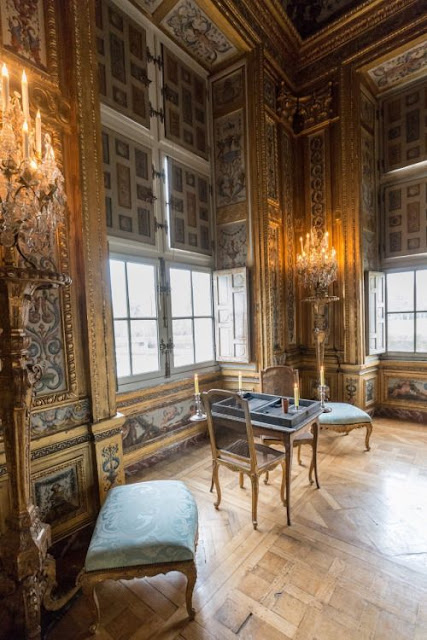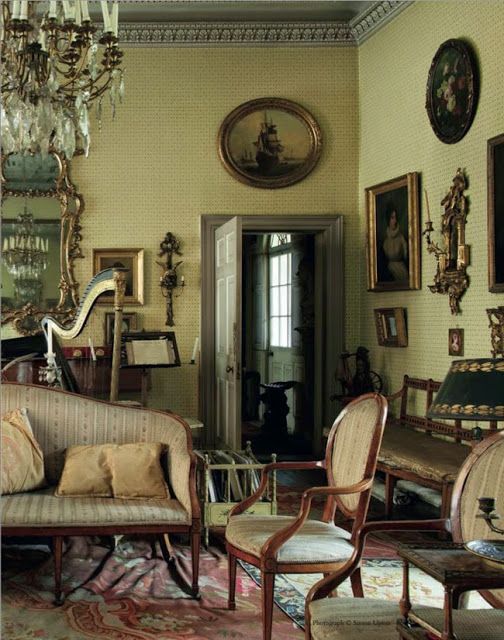A girandole, JEER-on-dole (from French, in turn from Italian girandola) is an ornamental branched candlestick consisting of several lights, often resembling a small chandelier. Girandoles came into use about the second half of the 17th century, and were commonly made and used in pairs.
A girandole has always been a luxurious source of lighting in the great 18th-century period of French house decoration. There are girandole table lamps, sconces, and even chandeliers as you will see in the pictures below.
Although the name is Italian in origin, girandoles reached the greatest heights of popularity in the second half of the 18th century in France and England. At the beginning of this period these gilded bronze and crystal beauties represented the most extravagant expression of the Rococo style of lighting.
Beautiful and charming, French girondoles will add a wonderful old world feeling to your home no matter what room you you choose to use them in. I hope you will enjoy learning about them and viewing the images I have gathered to share with you.
Jacques Garcia
Girandoles are prized standout pieces that are utilized today as decorative objects in old world interiors. Once used as mantel ornaments they are usually found in pairs.
The French girandole was designed to look like a fountain in the center with arms arranged around a central axis and radiating outward like the spokes of a wheel. They were also well decorated with prisms and beads of glass that gave the impression of water droplets. The use of all the ornamentation had a purpose other than aesthetics.
Before the advent of electric lighting it was important to try and produce as many reflective surfaces for the candle light as possible through the use of multifaceted beads as well as prisms that would reflect and refract as much light as possible from the candles.
Large girandoles were placed on tall candle stands called torcheres that raised them as high as the wall sconces. Added all together the three sources of light, (chandelier, sconces, and girandoles) produced enough light to illuminate the centers of rooms. The use of smaller girandoles on tables and roaring fires in fireplaces helped to bring light towards the floor.
They understood the use of mirrors and crystals to create lighting in the court of Versailles. Here, in the Hall of Mirrors, gilt guéridons hold girandoles up as high as possible to help light the corridor..... especially at night.
No one seems to know who created the girandole but they were first seen in French royal inventories as early as 1660.
Beautiful girandoles in the apartement of the marquise de Pompadour.
Fireworks.... or girandoles at Versailles.
The earliest uses of the word girandole in the 17th century, referred to a kind of firework or to something, such as a fountain, with a radiating pattern like that of a firework. You can see the similarity and why this style of firework is where these wonderful lamps got their name.
Another firework style that resembles the girandole.
By the 18th century, the word girandole was being used for a branched candlestick. With this close up you really get the idea of why they called it a girandole due to its resemblance to the firework.
This size is perfect for table lamps and will add a wonderful old world feeling to your home.
Lisa Farmer-Eye For Design
I have a pair that I use on top of the desk in my office. I found them in a old antique car parts place.......just laying on a pile of stuff. Went for a part and came home with girandoles.
Lisa Farmer-Eye For Design
This image is from last Christmas. I forgot to light the candles. Just imagine that they are even more magical when lit.
Suitable for a hallway, living room, bedroom, sitting room, dining room. You can't go wrong with girandoles anywhere in your interior.
K&Co. Antiques
Some French Girandole table lamp candelabras have glass toppers like these.
Others do not.
Girandoles were popular throughout the 18th century. Sometimes people used semi precious stones such as garnet, amethyst, carnelian, even agate alongside their prisms.
Dejavu on Instagram
The girandoles that have an aged patina instead of a shiny metallic one pair beautifully with French provincial and Gustavian elements.
via Pinterest
French Brocante themed interiors are primarily white or grey. Lovely crystal girandoles will add a little bit of glamour to these interiors.
Some people prefer a simpler look with only prisms for adornment.
While others like to embellish their girandoles with strings of glass beads.
This image and the one below from vignetteantiques.blogspot.com
Another popular way to display your girandole is with shades.
Rodolphe on Instagram
The urn based girandoles are also very striking.
They look so pretty with distressed or even chippy paint furniture.
via Pinterest
Oh my.....girandole Heaven!
House of Porters
The timeless styling of the girandole is an Old World design that will never go out of style.
Next up we have the French girandole sconce. They have the similar fountain/firework design of the table lamps.
via Pinterest
Girandole sconces (or brackets as they were called) were objects of luxury that reached their height in popularity in England and France in the second half of the 18th century.
Designer, Jacques Grange
Lisa Farmer-Eye For Design
In addition to my girandole table lamps I also have a girandole wall sconce in my office.
Always present are the radiating hooked arms.
via Pinterest
This dreamy, creamy space features a French girandole table candelabra and chandelier.
The girandole chandeliers will also always resemble the style of the table lamps with the hooks that create the fireworks look.
The hooks are what give them their distinctive look.
via Pinterest
Girandoles are getting harder to find and when you do they can be quite expensive.
However, they are still out there and you might get lucky as they can turn up at the most unexpected places.......just ask me.
Click here to see the previous post
This blog post was published by Lisa Farmer
In the event that I have not credited the correct source of an image, please contact me at lisafarmerdesigns46@yahoo.com and I would be glad to correct it.




























































































